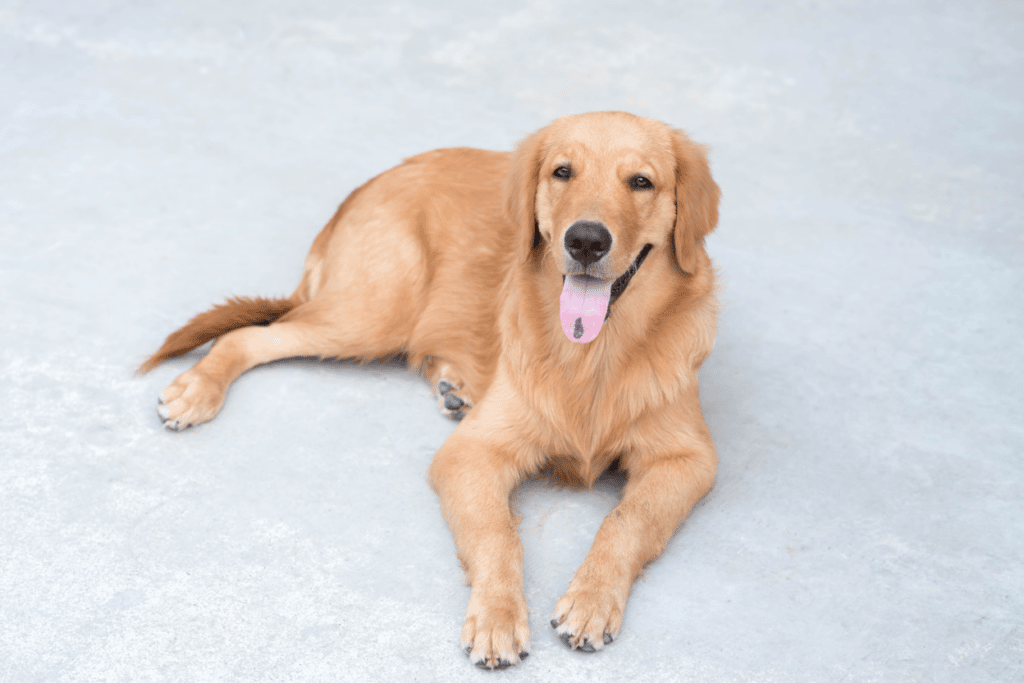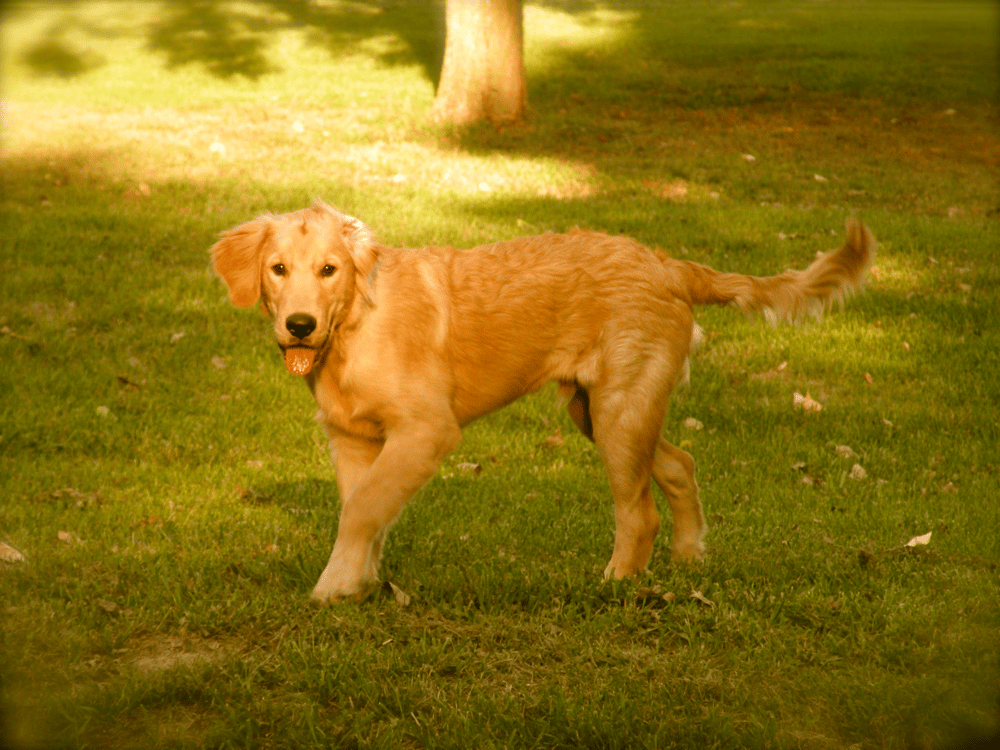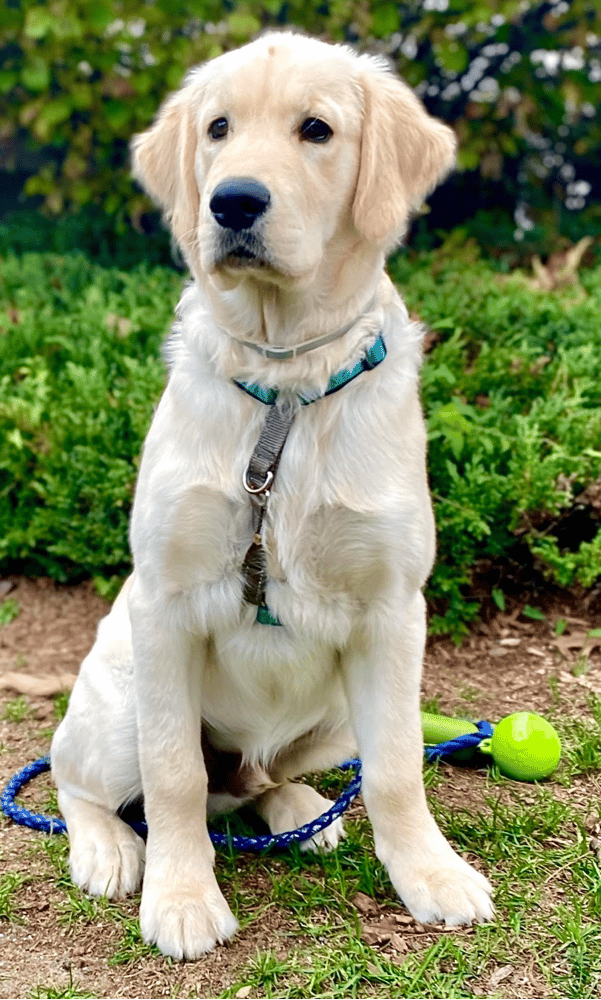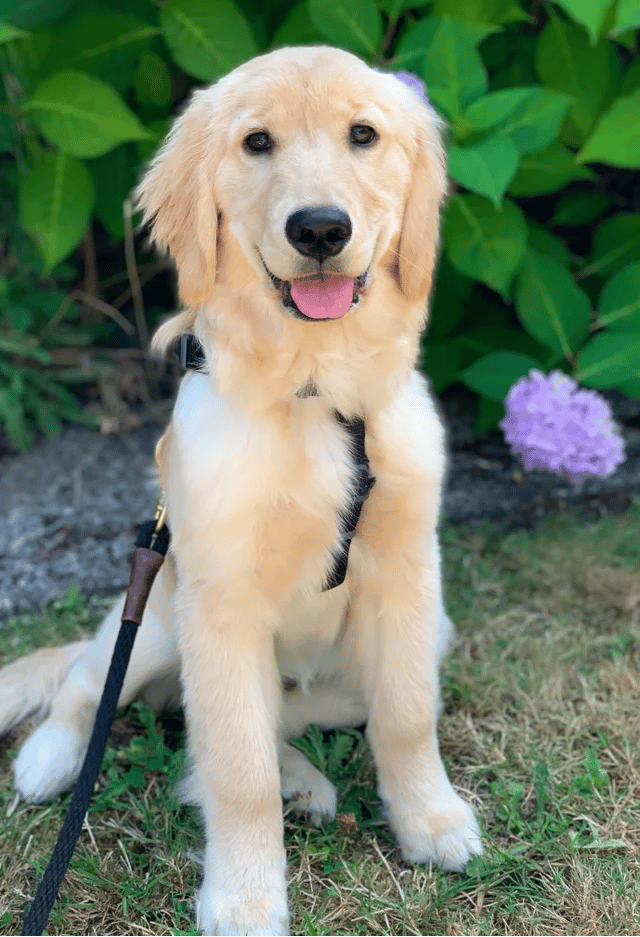Contents
- Five-Month-Old Golden Retriever: Doggie Tweens
- What does a Five-Month-Old Golden Retriever Look Like?
- Socializing a Five-Month-Old Golden Retriever
- Energy and Exercise with a Five-Month-Old Golden Retriever
- How Big Is A 5-Month-Old Golden Retriever
- How Much Do Five-Month-Old Golden Retrievers Sleep?
- How Much Exercise Five-Month-Old Golden Retriever Needs
- How to Train Your Five-Month-Old Golden Retriever
- How Much to Feed Your Five-Month-Old Golden Retriever
- Dealing with Your Five-Month-Old Golden Retriever’s Chewing
- Conclusion
Time has flown by these past few months, and now your Golden Retriever pup is five months old! It probably seems like it went by in a blur and they were a handful just a few weeks ago.
Now your pup is rapidly approaching the point where they transition from their puppy phase into canine adolescence, which is like the teenage years for dogs, and it starts at around 6 months of age.
That’s right. Your cute little puppy is about to become a teenager!
You’ll start seeing some small signs that your puppy is transitioning to adolescence this month, however, they’re technically still a puppy.
To help you be the best puppy parent you can be, we’ll teach you all about:
- What to expect from your five-month-old Golden Retriever pup
- How big a five-month-old puppy can get?
- How much does a five-month-old Golden Retriever sleep?
- How much exercise your puppy needs at five months
- How to train your five-month-old golden puppy
- How much to feed your five-month-old Golden Retriever
Five-Month-Old Golden Retriever: Doggie Tweens

A lot of people refer to this milestone as the “angel stage” because your puppy has been around long enough to learn your routines and what’s expected from them on a daily basis.
You’re probably breathing easier and living a more comfortable life with your pup than you did when you first brought them home.
Your pup is likely doing very well with potty training, and they probably sleep comfortably through each night.
Because of your devotion to training, your pup is paying attention to you and learning from you.
You’ve got a big baby with puppy dog eyes and a heart that beats only for you!
But then there’s the other side of that coin. You’re likely starting to notice some red flags that indicate that adolescence is coming.
The puppy that you thought was a perfect angel has randomly decided to chew up and shred things the second you weren’t watching them, even though they hadn’t bothered with such things previously.
Maybe they’ve started stealing food off the counters or table.
Or they don’t listen when you give them a command, despite the fact that they’ve been really good at obeying you in the past.
It probably seems that they’re doing their own thing and not paying attention to you or your rules right now.
Unfortunately, six months marks the canine adolescence milestone, so your pup is going to start displaying some of these changes at five months old while they’re transitioning.
Don’t worry though. This phase will eventually end.
Puppies follow a similar growth pattern as humans: puppy, teenager, adult.
They experience behavioral, physical, and social development during these phases. But because every puppy grows at a different rate and acts differently based on their own personality, it’s hard to tell you when your pup will enter adolescence, and we can’t tell you how long it will last, either.
It doesn’t matter whether you’re still experiencing the “angel stage” or whether you’re frustrated dealing with the beginnings of adolescence, this part of your pup’s development is completely normal, as are your feelings about it.
You’ll need to provide your pup with a lot of support, as well as firm guidance, to help them grow. And your pup will require consistent training using positive reinforcement.
What does a Five-Month-Old Golden Retriever Look Like?

What was once a ball of fluff is now a tall and lanky pup. Your golden will probably have long legs that seem out of place with the rest of its body.
Their adult coat will be growing in, and they’ll begin to lose their puppy coat. During this transition, you’ll probably notice a slight change in the color of their coat.
Some of their teeth will probably be missing, as well. They’re losing baby teeth during this time.
Socializing a Five-Month-Old Golden Retriever
The critical window for socialization is 4 months, but this doesn’t mean you should stop working with your pup.
Keep taking your pup out and letting them have positive experiences with different places, people, and animals. The goal is to expose them to various things they’ll experience as an adult.
Golden Retrievers tend to be really friendly, so you’re going to need to teach them that they don’t need to socialize with every person or animal they see.
Energy and Exercise with a Five-Month-Old Golden Retriever
Your puppy will have more energy now because they’re closing in on their adolescent stage and leaving their puppy stage behind.
Young puppies don’t have the same sort of energy that an adolescent dog does, and it’s easy for them to tire out.
You’ll notice that your five-month-old golden can go for longer. They’ll be able to exercise for longer periods of time before they need a nap.
In general, you’ll see a mixture of both puppy and teen behaviors in your five-month-old golden because five months is the equivalent to the tween stage for us humans.
How Big Is A 5-Month-Old Golden Retriever

On average, 5-month-old goldens weigh 25-50 lbs. That’s a big range, and it’s because every puppy is different. If your puppy weighs more or less than that by a few pounds, that’s likely normal, too.
If a golden pup is smaller, that doesn’t mean that it’s unhealthy, and if a puppy happens to be tall and weighs more it doesn’t mean that they’re overweight.
You should talk to your veterinarian before you jump to any conclusions about your puppy’s weight.
In general, it’s better to have a puppy that’s more on the lean side of the spectrum than a chunky pup. This is because Golden Retrievers are prone to health problems like hip dysplasia and other joint issues. They’re also prone to eat too much and become overweight. So, a lean pup means that they won’t have extra weight that causes undue stress on their little joints.
How Much Do Five-Month-Old Golden Retrievers Sleep?
Your puppy still needs tons of sleep, even though they’re the size of some fully grown dogs.
Puppies can’t grow and develop properly without getting the right amount of sleep.
Five-month-old puppies should get around 18 hours of shut-eye per day.
This is a little deceptive. They don’t actually have to be sleeping that whole time, but they do need to be resting quietly.
It’s important that you don’t try to exercise your puppy to the point of utter exhaustion in an attempt to “burn off energy”. This can actually overstimulate them and leave them overly tired, which will cause them to act up, bark, bite and bounce off the walls.
Puppies that are overly tired act wild, and it’s not fun to deal with. It can also be a real pain to get them to calm down and go to sleep once they’ve reached this state.
So, to avoid an overly- tired and wild puppy, you should help them to take a nap and get the rest they need.
A good rule of thumb is that if your pup has been awake and playing for a couple of hours, it’s time for a nap.
It’s a good idea to use crates or pens to help your puppy develop a healthy sleep routine. They like to be involved in whatever you’re doing, so if you don’t have them in a crate or pen and decide to go to another room, they’re likely to follow you instead of nap.
You may want to give your pup a soft chew toy to chew on as they drift off to sleep. Puppies chew and lick as they’re going to sleep as these are comforting actions for them.
Keep the environment that you’ve chosen for your puppy’s sleep space comfortable. It’s been a few weeks (or months) since you’ve brought your puppy home, and it’s pretty likely that the temperature is either warmer or cooler than it was before. So, you may need to change the temperature in their area so that they’re comfortable enough to go to sleep easily.
Your pup will let you know if it’s uncomfortable by acting restless. If this happens, then this means that they need more bedding or something more comfortable, or that the temperature isn’t right.
Another tip to help your pooch fall asleep more comfortably is to eliminate outside distractions. You can do this by putting a towel or blanket over your pup’s crate to block out visual stimuli, and turning on some white noise (like a white noise machine or a fan) to drown out other sounds during your puppy’s designated nap time. These may sound like unnecessary measures, but they go a long way to help ensure that your pup goes to and stays asleep.
How Much Exercise Five-Month-Old Golden Retriever Needs
As I’ve said before, you’ll notice that your pup has a bit more energy at this age.
They also have a bit more stamina and aren’t as likely to wear out as fast as they did before.
Your pup is able to take a 5 or 10 minutes walk and still have energy left over, when they would have been completely exhausted from a small walk when they were younger.
Your pup will love getting out in nature, so take your pup to hiking trails, parks, or really anywhere you can let them enjoy the great outdoors. Put them on a long leash (15 or 20 feet) so that they can run and play, getting the exercise they need.
Because Golden Retrievers were originally bred to hunt and work in fields, any time they get outside, they’ll be in their element and their instincts will kick in. You’ll notice that they’ll have a lot more fun and seem more like their true, authentic selves if you let them run and play on a long leash than they do when you take short walks around a suburban neighborhood.
There are so many more things to sniff at and explore! But you won’t have to worry about your puppy’s safety because the long leash gives them the freedom to explore while also ensuring they remain safe and within your grasp.
If there isn’t anything like a hiking or nature trail near you, go to a park. Heck, even an empty parking lot will give your pup a safe place to run around and explore.
If you’ve got a fenced-in yard, there are lots of ways you can play with your pup and make sure they get enough exercise.
Get a flirt pole toy for your pup. These are poles with toys attached to them with an elastic string.
Don’t do anything crazy with the toy or make your pup do backflips and acrobatics to reach it. Their joints and muscles are still growing and their growth plates haven’t closed. This means that sharp angles and intense exercise can lead to injury, which is obviously something you don’t want to cause your pup. Instead, use gentle motions like circles.
You can also play hide-and-seek with your pup. It engages their big brains and makes them think and get creative while also giving them a chance to exercise.
This requires two people. One needs to hold the puppy while the other hides, and once the person has chosen their hiding spot the person holding the puppy can let them loose to find their owner.
Don’t be surprised if you get mixed results from this game. Some golden puppies are hide-and-seek masters, while others really suck at the game. If your puppy isn’t doing so well, try making some noises to help them find you.
If you play games with your pup before you take them for a walk, you’ll find that you’ll be more successful at wearing them down, and they’ll be less likely to pull on the leash.
You need to keep in mind when you’re taking your puppy for walks that this practice is actually pretty unnatural to them.
They usually trot or gallop, while we walk more slowly, so they have to slow down to match our pace.
They also typically zig and zag around, which is a lot different from walking in a straight line on a leash.
And they’re guided by their noses and sense of smell. So they frequently stop to sniff and investigate things.
However, your puppy will be more successful at walking with the leash once you’ve already burned off some of their energy by playing with them. They’ll be a little worn out, which will help them to concentrate on the task at hand.
Of course, no matter which sort of exercise you choose, you should pay attention to your pup and let them decide what they can handle.
Even though they have more energy than they did months prior, that doesn’t mean that they can do the things that adult Golden Retrievers can yet.
If your pup flops down to take a break, let them. They’re run out of energy and need a time out before getting up and starting again.
How to Train Your Five-Month-Old Golden Retriever
Puppies are programmed to know how to live and act around other dogs, not humans. They don’t know rules that we consider to be pretty basic.
So because they don’t know how to live in our world, training is really important.
Training isn’t something you can do once and then just be done with. Instead, it’s a lifelong process of praising your dog when they do something good and correcting them when they do something you don’t like. And though it’s a lot of work, it’s worth it in the long run.
The good news is that training doesn’t have to be all business. It can be one of the activities that make your pup form the strongest bonds with you, and it can be fun, too.
You’re going to want to avoid any training methods that involve punishment, fear, or negative emotions with your golden. It’s long been understood that Golden Retrievers respond more to positive reinforcement techniques, so treats and praise will work better than yelling at your pup.
Anything your pup does that results in praise and treats will be something they’ll want to repeat. (They like treats!)
Keep treats in various locations throughout your house so that you can easily reward your pup for good behavior, no matter which room you’re in.
It might sound like it’s too good to be true that if you reward your dog for good behavior they’ll repeat it, but it’s really that simple. Golden Retrievers are people-pleasers, and if you’re happy they’ll do whatever they can to replicate that.
However, you need to correct them when they do something they’re not supposed to because they’ll repeat those actions if you don’t.
But don’t yell and get upset when your puppy does something you don’t want them to do. Instead, change up their environment so they can’t do it again.
For instance, if your puppy is jumping on people when they come into your house, then put your puppy in their crate or behind a gate before you answer the door.
If your pup is knocking your company’s children down while they’re playing in the yard, then put your puppy inside in their crate or pen and give them a chew toy instead.
If you’re proactive rather than reactive, you can stay on top of things and prevent your pup from acting up.
After a bit, you can work with your pup to eliminate these behaviors by doing things like teaching your puppy to go lay down when you answer the door or playing more gently with kids.
Because potty training isn’t done yet, make sure that you’re letting your pup go potty outside lots.
Your puppy hasn’t developed the skills to reliably tell you when they need to go potty, so you need to let them go regularly to prevent accidents.
You’ll also need to continue to work on your puppy’s “alone” skills. By this age, your pup is likely at least familiar with the idea. But it’s one of those things you’ll need to persistently work with them about because Golden Retrievers are really prone to separation anxiety.
The best way to get your pup slowly acclimated to spending time home alone is to gradually increase the amount of time you’re away from home yourself.
Here are some other things you can work on with your pup:
- Coming to you when called
- Walking on a leash
- Laying down on their bed or mat when told
- Greeting guests politely
- “Sit”, “stay” and “down” commands
- Learning to drop things when told
Training lessons don’t have to belong. In fact, you want to keep them short so your pup isn’t frustrated and bored.
Many people think that you shouldn’t end a training session until you’ve achieved a positive action, but if it isn’t going well then you should just call it a day.
If your puppy isn’t into it, then try again tomorrow.
It’s important that you praise your puppy for trying, but then you need to think about the session and see if you can figure out where it went wrong.
Maybe there was something distracting in their environment. Maybe your pup was too tired to properly learn something right then. Or maybe you could split the task up into smaller pieces so it’s not confusing to your pup.
Try to remember that training isn’t always a pass/fail task. It’s a lifelong journey. Just try to enjoy the ride and make it fun for both you and your pup.
How Much to Feed Your Five-Month-Old Golden Retriever
Five-month-old puppies generally eat between three and five cups of food a day.
The exact amount depends on the food you’re feeding your pup, as well as their individual needs.
Your puppy may become “hangry”, which is a good indication that you need to feed them more.
If you have questions about how much you should feed your pup throughout the day, or think your pup may not be getting enough to eat, then you should ask your veterinarian.
It may seem odd, but you should pay attention to your pup’s poop too. If it’s consistently soft, then you should probably change the food you’re feeding them. Some goldens are prone to food sensitivities, and their poop is a good way to find out if your pup is having issues.
If you think you may need to switch foods, talk to your veterinarian. You can check out the post for the best puppy food for your golden pup.
Dealing with Your Five-Month-Old Golden Retriever’s Chewing
I probably don’t have to tell you that your five-month-old Golden Retriever puppy is right in the middle of the peak of its chewing phase.
Your puppy is losing their puppy teeth, which makes their gums really painful and uncomfortable, which is what causes them to chew and bite. So, try to keep that in mind when you’re dealing with it. They’re just doing what comes naturally to them to do.
They’re not maliciously destroying your furniture, shoes, or other things you love, and they don’t mean to hurt you when they bite you.
Make sure you have lots of chew toys around for your pup during this time. Seriously, you can’t have enough!
It may make your home look a bit messy, but having a ton of toys and chewing sticks or bones all over the floor is better than having your puppy chewing up inappropriate things.
It’s not uncommon for Golden Retriever puppies to delight in carrying around toys that seem too big for them. So, find a big soft toy for them to fall in love with.
If you find that your puppy likes to chew on things that make a crinkly noise, find them some toys that crinkle.
I signed up for Bark Box for my dogs and they love all the treats and toys that come in it each month. They generally send a good combination of soft toys that squeak and toys that crinkle, as well as puzzle toys to keep their minds occupied.
You’ll want to keep your belongings out of reach of your puppy to prevent chewing, too.
Another tip is that you CAN NOT trust your puppy at home alone not to chew on things while you’re gone, even if your pup has acted like a perfect angel in your presence for days.
When you leave, you should put your pup either in their pen or in a crate. As a matter of fact, any time you can’t keep an eye on your pup you should crate them.
The good news is that teething isn’t a permanent state; it’s just a phase.
Conclusion

Taking care of a puppy is a lot of work, no matter how old they are.
It doesn’t matter if you’ve bonded with your puppy and they’re now your best friend, it’s still going to be physically and mentally draining to take care of them at times.
But you should keep going anyway. Your reward will be a well-adjusted and fully- developed and grown dog that will make an awesome lifelong companion!
If you get discouraged, find a way to have fun with your puppy. It will not only lift your mood but teach your pup to trust you.
If you haven’t found the right Golden Retriever puppy for you yet, check out our article about How to Find Reputable Golden Retriever Breeders.
If you’ve missed the other articles in this series, you can check them out here:
- Golden Retriever Puppy Growth and Development Month By Month
- 6-Week-old Golden Retriever Puppies
- 8-Week-old Golden Retriever Puppies
- 3-Month-old Golden Retriever Puppies
- 4-Month-old Golden Retriever Puppies
- 6-Month-old Golden Retriever Puppies
- 7-Month-old Golden Retriever Puppies
- 8-Month-old Golden Retriever Puppies
- 1-year-old Golden Retriever Puppies
- 2-Year-Old Golden Retriever: Full-Grown, Adulthood, Playful
- Senior Golden Retriever: Signs of Aging and How to Care for Your Old Dog
